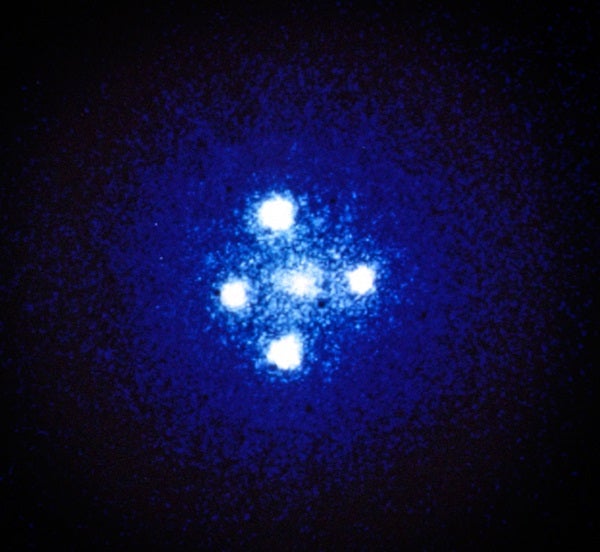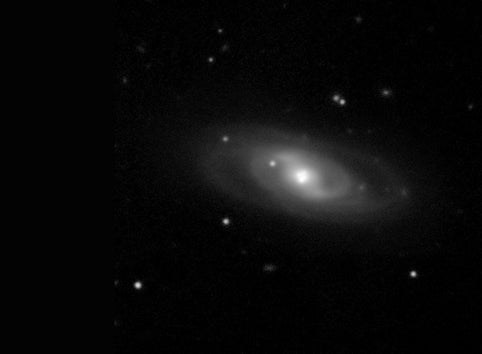By now, everyone knows that space can warp. Albert Einstein’s 1916 general theory of relativity predicted this, and it was later affirmed when a star in Taurus next to the eclipsed Sun appeared slightly shifted, the path of that star’s light to Earth altered by solar gravity. But no one imagined a practical use for this phenomenon.
Russian physicist Orest Chwolson gets credit for being the first, in 1924, to explain how the perfect alignment of a nearer massive object and a distant luminous one could create a ring surrounding the foreground entity, as its gravity influences the paths of the passing photons. It would, in effect, act like a lens and bend the light. Einstein more famously discussed this 12 years later, but said it would never be actually observed because he thought the chances were too slim of a star ever perfectly lining up with a background one.

Bringing the universe to your door. We’re excited to announce Astronomy magazine’s new Space and Beyond subscription box – a quarterly adventure, curated with an astronomy-themed collection in every box. Learn More >>.
The next year, in 1937, brilliant iconoclast Fritz Zwicky offered a far more optimistic appraisal. He mathematically showed that a galaxy cluster, which occupies far more angular area in the sky than a single star, could serve as the lens to focus the light of a bright distant object into a ring or, if the alignment was less perfect, a series of arcs or even several points.
That’s where the matter stood for the next 42 years. Like tuna fish mixed with colored marshmallows, it existed only as a bizarre notion.
Everything changed in 1979, however, with the discovery of the first gravitationally lensed object — QSO 0957+561, object number 40 on our 50 Weirdest list. That bizarre “twin quasar” revived the issue and started the ball rolling toward serious searches for additional lenses.
Astronomers then realized that this phenomenon could be exploited. For starters, the foreground lens can boost the brightness of anything in the background, effectively creating a “gravitational telescope.” By cranking up the light of otherwise impossibly dim and faraway background entities, astronomers this past decade have discovered the most distant, record-setting galaxies and quasars.
Those familiar with optics might wonder about the focal length or focal point of such a lens, but there is none. Instead, a gravitational lens has a “focal line” — a direction — and an observer anywhere along this line will see the altered background object enhanced in brilliance and also distorted into a ring, arc, series of arcs, or series of bright points, depending on the exact alignment.
If a gravitational lens fails to brighten an object, the background galaxy or quasar might still be detected as stretching or arcing, always perpendicular to the direction toward the lens. Finally, there’s “microlensing,” where distortion is absent but a subtle brightness variation appears over time.
This is the principle behind the amazing Optical Gravitational Lensing Experiment (OGLE), which began in 1992 and detected many unseen stars and even extrasolar planets as it hunted for signs of dark matter.
Since the paths through space of each of the lensed images are not the same length, astronomers observe a time delay between them. We see one image before we see the other. If flickering or spectral changes occur, we watch them unfold in sequence.
All of this provides background and preamble to the Einstein Cross, which is the quadruply lensed quasar Q2237+030. This object, 8 billion light-years away, happens to lie precisely behind a foreground galaxy named ZW 2237+030, which itself has come to be called Huchra’s Lens. Its gravity intercepts the quasar’s image and breaks its light into four separate, complete copies, creating a nearly perfect cross. The barely visible lensing galaxy appears at its center.
Some 400 million light-years away, the lensing galaxy is 20 times closer to us than the distant quasar. If you’ve never noticed this strange configuration in the night sky in the southern part of the constellation Pegasus, that’s because it is 17th magnitude — well beyond the visual range of most backyard telescopes and 25,000 times fainter than the dimmest naked-eye stars. Moreover, the size of the Cross is a challenging and minuscule 1.6 arcseconds, smaller than the angular width of Neptune. Those enamored of nomenclature can call the individual quasar copies Q2237+030A, B, C, and D.
Lensing and microlensing remain a hot avenue of ongoing studies. Beyond the brightness boost and the routine discoveries of ever-more-distant “farthest galaxies,” astronomers can sometimes detect the orbital motion of lensed members of binary star systems. This phenomenon is now called the “xallarap effect.” It is just like parallax (which is why it’s that word reversed), where apparent celestial motion yields useful information, all due to Earth’s shifting orbital position. Except, here it is the double-star’s shifts against the lens alignment that produces the change.
Try using “xallarap effect” in your next game of Trivial Pursuit. If anyone knows it, marry them.











